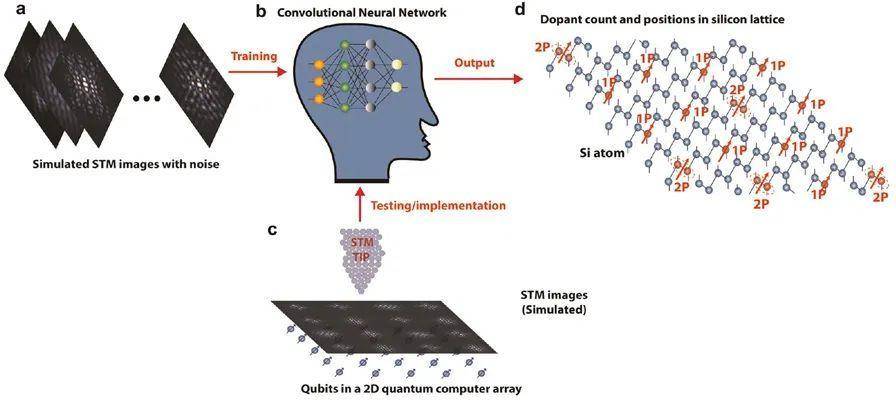科技工作者之家
科技工作者之家APP是专注科技人才,知识分享与人才交流的服务平台。
科技工作者之家 2020-07-16
来源:知社学术圈
在实现量子计算架构的领先技术中,基于硅的单个掺杂原子的自旋量子位正日益受到关注。基于原子交换的量子计算机设计方案中,原子与量子位之间的物理距离很小(10-15 nm),放大到大型二维阵列的方法,通常取决于量子位调控及其相互作用的均匀性。对于单个或多个掺杂原子的量子位,即使在一个晶格位点的水平哪怕只有很小的变化,也可能显著影响逻辑运算的设计和调控。对于大规模阵列而言,建立一种可靠且快速识别每个量子位原子数、表征精确空间(原子在晶格中的位置)的方法至关重要。
来自澳大利亚墨尔本大学量子计算与通信技术中心Muhammad Usman等首先建立了一个通用的框架,其输入是一个电子波函数的模拟扫描隧道显微镜(STM)图像,该图像限制在单个掺杂剂或紧密排列的掺杂剂的小簇上。他们开发了两种特征检测方法,即边缘检测和特征平均,对图像进行处理以优化对系统已知信息的利用(例如晶格几何形状和表面二聚体)并减少计算负担。他们的结果表明,两种特征检测方法都可以在低噪声水平下实现高保真量子位表征,而特征平均方法在较大的模糊噪声的情况下可提供相当优越的性能。他们训练卷积神经网络(CNN)来表征嘈杂的STM图像,并查明相应的掺杂原子位置以精确的晶格位点精度进行计数。为了演示已建立方法的工作原理,他们在模拟STM图像上对CNN进行了训练和测试,包括与发表的测量结果相称的噪声水平下的测试。作者注意到,先前计算出的STM图像在每个像素和特征的水平上均与实测图像显示出非常好的一致性,因此他们希望训练后的CNN能够准确表征实验图像相当于带有噪声的模拟图像。由于CNN的训练需要数千张图像,因此基于模拟图像进行训练的能力消除了执行大规模实验测量的需要,从而节省了大量时间和精力。
Framework for atomic-level characterisation of quantum computer arrays by machine learning
Muhammad Usman, Yi Zheng Wong, Charles D. Hill & Lloyd C. L. Hollenberg
Atomic-level qubits in silicon are attractive candidates for large-scale quantum computing; however, their quantum properties and controllability are sensitive to details such as the number of donor atoms comprising a qubit and their precise location. This work combines machine learning techniques with million-atom simulations of scanning tunnelling microscopic (STM) images of dopants to formulate a theoretical framework capable of determining the number of dopants at a particular qubit location and their positions with exact lattice site precision. A convolutional neural network (CNN) was trained on 100,000 simulated STM images, acquiring a characterisation fidelity (number and absolute donor positions) of >98% over a set of 17,600 test images including planar and blurring noise commensurate with experimental measurements. The formalism is based on a systematic symmetry analysis and feature-detection processing of the STM images to optimise the computational efficiency. The technique is demonstrated for qubits formed by single and pairs of closely spaced donor atoms, with the potential to generalise it for larger donor clusters. The method established here will enable a high-precision post-fabrication characterisation of dopant qubits in silicon, with high-throughput potentially alleviating the requirements on the level of resources required for quantum-based characterisation, which will otherwise be a challenge in the context of large qubit arrays for universal quantum computing.
来源:zhishexueshuquan 知社学术圈
原文链接:https://mp.weixin.qq.com/s?__biz=MzIwMjk1OTc2MA==&mid=2247504636&idx=2&sn=45452cf9566397a4bb731531c9b17328&chksm=96d42c03a1a3a5151f18818432d6223762ce857e4aa29f2e0e1d875931418211ea76118e16d4#rd
版权声明:除非特别注明,本站所载内容来源于互联网、微信公众号等公开渠道,不代表本站观点,仅供参考、交流、公益传播之目的。转载的稿件版权归原作者或机构所有,如有侵权,请联系删除。
电话:(010)86409582
邮箱:kejie@scimall.org.cn

组成一切物质的原子,有一半都是来自其他星系

微软量子计算机新进展:规模化量子计算的关键组件

德美科学家联手,量子计算机研发获里程碑式突破

可编程量子计算机再现“量子霸权”

人工智能可高度准确判断自杀倾向

新技术让不同编码的量子计算机之间互通信息

量子计算机可以做什么?

IBM研发出无监督式机器学习算法

液态金属有望催生一系列战略性新兴产业

IBM宣布成功研制50量子位原型机